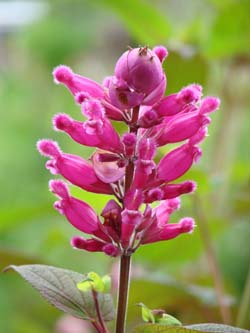(Giant Karwinski's Sage) San Francisco arborist and gardener extraordinaire Ted Kipping developed this tower of creamy pinkalicious power that hummingbirds love. It's lush with bright green leaves that are large, pebbly and hairy on the underside.
Salvia karwinskii 'Ted's 18 Footer' reaches heights almost double those of our other tallest varieties of this tough shrub. It's long bloom season includes winter, during which it can withstand short periods of freezing weather as low as 20 degrees F and still keep blooming.
Due to its generous size, Ted's 18 Footer should be planted where protected against winds. A south-facing wall is ideal for winter warmth. Although this sage will thrive with average watering based on local conditions, it loves moisture. As to soil, it isn't picky but needs good drainage.
Ted's 18 Footer is deer resistant and is an excellent choice as a dramatic accent, screen or background plant.
To encourage upright, compact growth, periodically remove some of the flowering branches. Or you can prune the plant down to a few active growth nodes once a year at the end of its winter flowering season when it appears there will be no more frost.
The parent species of Giant Karwinski's Sage comes from moist mountain areas in Mexico and Central America. In the wild, it's found in oak or pine forests at altitudes of 4,000 to 8,000 feet. Both the scientific and common names honor German botanist Baron Wilhelm Friedrich Karwinsky von Karvin (1780-1855) who explored Mexico in the early 19th century.
Question?


